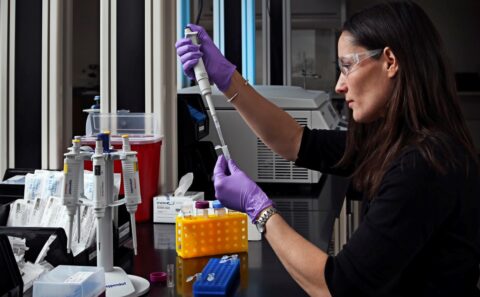What really makes us tick? In the digital age, there is very little that is still unknown or unknowable. We can find detailed answers to life’s most complex problems in a fraction of a second, at the touch of a button. And yet when it comes to the questions that matter most to us – like how we can live happier, healthier and longer lives – we are in many ways, still in the dark. We’ve been strangers to our own health, often neglecting it until we become ill, and even then, engaging with it only through the intervention of a healthcare professional. But what if we could take control of our health before an issue arises? What if we were able to minimize the impact of disease, manage symptoms and side effects, and precisely tailor treatment to our unique bodies? A new generation of preventative and diagnostic technology is redefining our relationship with health and shifting our focus from reactive to proactive healthcare.
How does healthcare look today?
The world spends USD 7.8tn on healthcare every year; it accounts for one of the single largest portions of any country’s budget. Yet while spending continues to increase (due to our aging population and the steady rise in chronic illness), outcomes point to a much more complex picture. For instance, although the United States spends nearly twice as much on healthcare as a share of the economy than the average OECD country, its life expectancy is below average. Compared to a group of ten peer nations, it also has the highest number of hospitalizations from preventable causes, and the highest rate of avoidable deaths. It’s clear that in healthcare, how you spend matters far more than how much.
How did we get here?
The success of pharmaceuticals and “miracle” therapies in the last century directly shaped our attitude towards modern medicine. The prevailing wisdom was: “if you become sick, we can try to fix you”. Societies began to view healthcare reactively, focusing almost entirely on curing illness rather than preventing it, and becoming increasingly reliant on drugs and medication as we did so.
And yet when it comes to proactive healthcare – the prevention and diagnosis of disease – we have only scratched the surface of what is possible. The vast majority of investment is still funneled into developing reactive treatments, while proactive measures such as early-stage diagnostics have been critically overlooked and undervalued.
Making the invisible, visible
Diagnostics fall broadly into three categories: pathology (testing samples of a patient’s blood, urine, saliva); radiology (using imaging such as MRIs or X-Rays); and quick screening methods like checking a patient’s temperature or examining their eyes or tongue for signs of illness. It’s estimated that 70% of all medical decisions are driven by diagnostic testing, and yet the sector is woefully underfunded, receiving no more than 7% of total biomedical research dollars.
A chronic condition (such as diabetes, cancer, or heart and lung disease) that is detected in its earliest stages is significantly easier to manage and treat. Diagnostics empower us to be far more effective in avoiding debilitating illness from the outset. For instance, a third of Americans living with Type 2 diabetes aren’t even aware they have it. In India, home to an estimated 77m diabetics, this number is closer to half. However, with early diagnosis, this disease can be managed well – and even reversed – particularly with the intervention of new technologies. Take Livongo, for example, whose smart touch monitor allows people with diabetes to track, control and share their blood glucose levels with trained professionals, who will contact them within minutes if they are at risk. These kinds of innovations are unlocking a powerful paradigm shift on what is now a global epidemic.
“An ounce of prevention is worth a pound of cure”
We are entering an era in which health systems will be largely defined by the speed, accuracy and accessibility of diagnostic tools and analytics. These tools have the potential to dramatically reduce healthcare costs and, crucially, improve the everyday health and life expectancy of billions of people worldwide. And unlike reactive healthcare, which is dominated by large pharmaceutical incumbents, innovation in breakthrough diagnostics can spring from anywhere – often coming from industries outside of healthcare altogether.
Consider this; a person’s risk of developing a chronic condition is mostly determined by a few key factors: genetic make-up, environmental concerns and lifestyle – all of which can now be easily assessed by a doctor or continuously monitored by the patient themselves. Is my heartbeat irregular? I’ll check my Fitbit. Is it possible that I might be going deaf? My AirPods will tell me. Does my family history mean I’m more likely to develop cancer? A simple blood test will pick that up.
Rewiring healthcare
Already, wearables have put medical-grade technology in our hands, allowing us to monitor our vitals in real time, and empowering us to seek immediate care if a warning sign is detected. Wearables have made everyday healthcare convenient, engaging – enjoyable even – for millions of people. And this is only the beginning. Over the next six years, the wearables market is expected to grow to USD 104bn, up from USD 37bn in 2020, with Asia Pacific expected to witness the highest growth rate.
As with every sector of industry, physicians will begin to rely more readily on artificial intelligence to process data and assist them in making appropriate diagnoses and recommendations for their patients. With this new depth of insight, it becomes possible to tailor treatment at an individual level, rather than relying on an inadequate “one-drug-fits-all” approach. This can be seen particularly in cancer treatment, where companies such as Foundation Medicine have an increasing ability to understand a patient’s genetic make-up, enabling doctors to create a highly precise, customized treatment which targets specific genes and doesn’t compromise the patient’s overall health. This kind of “personalized” or “precision” medicine is considered by many to be the new frontier of healthcare – but it is only made possible through accurate diagnostics.
Advancing a decade in 12 months
For investors interested in healthcare, now is the time to act. In 2020, equity funding in digital health globally hit an all-time high of USD 26.5bn, and for businesses in this area the forecast remains extremely positive. We’re seeing more IPOs from private healthcare companies, and the exit market looks strong, especially where interests align with governments and health insurance companies. Last year, in fact, exit activity in the medical device field reached its highest point in more than three years, with a total of 64 exits.
At Sagana, we are particularly excited by preventative healthcare, and we are seeing some incredibly inspiring players appear on the market. For example, let’s look at just one of the areas we’re focusing on: lung disease, which claims 8.8m lives every year. A huge number of these deaths can be prevented with a timely, accurate diagnosis. Right now, however, this relies heavily on a doctor listening to a patient’s breathing, and being able to tell the difference between the sound of a bad cough and one that might be life-threatening. Enter Feelix – the world’s smartest stethoscope, developed by Sonavi Labs. Feelix is a nextgen diagnostic device that records sound and uses embedded AI to diagnose lung disease. Its accuracy rate is a staggering 91%, compared to the 75% accuracy rate of physicians. The stethoscope can be used by doctors, untrained health workers in emerging markets, and by patients themselves, in their own homes. Today, a child dies from pneumonia every 39 seconds; the work of Sonavi Labs paints a much brighter picture for tomorrow.
What does the future hold?
Nobody is immune to healthcare. Our health is truly the most valuable asset we all have. Urgent investment in the field of early diagnostics is a clear way to scale solutions that will not only prevent unnecessary suffering and save lives, but encourage people to enjoy healthier lives, right now. Instead of waiting until the last minute to be treated for a disease, we can prevent the disease altogether. Rather than fighting for survival, we can enjoy the benefits of good health – at every stage of life. We are already looking forward to a healthier future, and that future starts right now.




